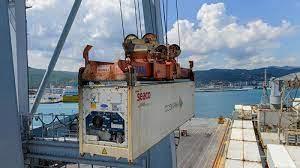 OVERVIEW
OVERVIEW
Total exports of bone-in broiler parts and feet during January-June 2025 attained 1,505,298 metric tons, 8.3 percent lower than in January-June 2024 (1,641,279 metric tons). Total value of broiler exports increased by 0.2 percent to $2,259 million ($2,255 million).
Total export volume of turkey products during January-June 2025 attained 87,186 metric tons, 15.7 percent less than in January-June 2024 (103,393 metric tons). Total value of turkey exports increased by 13.2 percent to $343 million ($303 million).
Average unit price for the broiler industry is constrained by the fact that leg quarters comprise over 96 percent of broiler meat exports by volume (excluding feet). Leg quarters represent a relatively low-value undifferentiated commodity lacking in pricing power. Exporters of commodities are subjected to competition from domestic production in importing nations. Generic products such as leg quarters are vulnerable to trade disputes and embargos based on real or contrived disease restrictions. To increase sales volume and value the U.S. industry will have to become more customer-centric offering value-added presentations with attributes required by importers. Whether this will increase margins is questionable given that leg quarters are regarded as a by-product of broiler production. A more profitable long-term strategy for the U.S. industry would be to develop products using dark meat to compete with and displace pork and beef in the domestic retail and institutional markets. Due to a shortage and hence high price for beef presentations this transition is now evident.
HPAI is now accepted to be a panornitic affecting the poultry meat industries of six continents with seasonal and sporadic outbreaks. The incidence rate and location of cases in the U.S. has limited the eligibility for export from many plants depending on restrictions imposed by importing nations. Although there have not been any incident cases in the U.S. for three months a resurgence is anticipated in the Fall.
Uncertainty surrounding tariff policy is an added complication potentially impacting export volume in 2025. In the event of reduced exports, leg quarters would be diverted to the domestic market resulting in a depression in average value derived from a processed bird.
EXPORT VOLUMES AND PRICES FOR BROILER MEAT
 During January-June 2025 the National Chicken Council (NCC), citing USDA-FAS data, documented exports of 1,525,413 metric tons of chicken parts and other forms (whole and prepared), down 7.8 percent from January-June 2024. Exports were valued at $2,322 million, down 1.0 percent with a weighted average unit value of $1,522 per metric ton but up 9.5 percent over the corresponding six months in 2024.
During January-June 2025 the National Chicken Council (NCC), citing USDA-FAS data, documented exports of 1,525,413 metric tons of chicken parts and other forms (whole and prepared), down 7.8 percent from January-June 2024. Exports were valued at $2,322 million, down 1.0 percent with a weighted average unit value of $1,522 per metric ton but up 9.5 percent over the corresponding six months in 2024.
The NCC breakdown of chicken exports for January-June 2025 by proportion and unit price for each category compared with the corresponding months in 2024 (with the unit price in parentheses) comprised:-
- Chicken parts (excluding feet) 95.1%; Unit value $1,410 per metric ton ($1,299)
- Prepared chicken 4.1%; Unit value $4,088 per metric ton ($4,212)
- Whole chicken 0.8%; Unit value $1,700 per metric ton ($1,650)
- Composite Total 100.0%; Av. value $1,522 per metric ton ($1,390)
The following table prepared from USDA data circulated by the USAPEEC, compares values for poultry meat exports during January-June 2025 compared with the corresponding months of 2024:-
|
PRODUCT
|
Jan.-June 2024
|
Jan.-June 2025
|
DIFFERENCE
|
|
Broiler Meat & Feet
|
|
|
|
|
Volume (metric tons)
|
1,641,279
|
1,505,198
|
-136,081 (-8.3%)
|
|
Value ($ millions)
|
2,255
|
2,259
|
+4 (+0.2%)
|
|
Unit value ($/m. ton)
|
1,374
|
1,501
|
+127 (+9.2%)
|
|
Turkey Meat
|
|
|
|
|
Volume (metric tons)
|
103,393
|
87,186
|
-16,207 (-15.7%)
|
|
Value ($ millions)
|
303
|
343
|
+40 (+13.2%)
|
|
Unit value ($/m. ton)
|
2,931
|
3,934
|
+1.003 (+34.2%)
|
COMPARISON OF U.S. CHICKEN AND TURKEY EXPORTS
JANUARY-JUNE 2025 COMPARED TO 2024
BROILER EXPORTS
Total broiler parts, predominantly leg quarters but including feet, exported during January-June 2025 compared with the corresponding months in 2024 declined by 8.3 percent in volume but value was up 0.2 percent. Unit value was 9.2 percent higher to $1,501 per metric ton.
During 2024 exports attained 3,251,000 metric tons valued at $4,689 million, down 10.5 percent in volume and down 1.1 percent in value compared to 2023. Unit value was up 10.7 percent to $1,442 per metric ton
Broiler imports in 2025 are projected to attain an inconsequential 67,000 metric tons (134 million lbs.) compared to 82,000 metric tons (180,000 million lbs.) in 2024
The top five importers of broiler meat represented 50.2 percent of shipments during January-June 2025. The top ten importers comprised 65.6 percent of the total volume reflecting concentration among the significant importing nations. Eighth-ranked China declined 55 percent in volume to 42,426 tons and 29 percent in value to $143 million over the first half of 2025 compared to the corresponding period in 2024
Nations gaining in volume compared to the corresponding period in 2024 (with the percentage change indicated) in descending order of volume with ranking indicated by numeral were:-
3. Philippines, (+46%); 5. Canada, (+23%); 10. Ghana, (+28%); 11. Haiti,(+22%);
12. Georgia, (+3%); 14. Dominican Republic, (+9%)
Losses during January-June 2025 offset the gains in exports with declines for:-
1. Mexico, (-2%); 2. Cuba, (-5%); 3. Taiwan, (-1%); 6. Guatemala, (-3%); 7.Viet Nam, (-19); 8. China, (-55%); 9. Angola, (-25%); 13. UAE, (-36%) and 15. Hong Kong, (-48%).
TURKEY EXPORTS
The volume of turkey meat exported during January-June 2025 declined by 15.7 percent to 87,186 metric tons from January-June 2024 but value was 13.2 percent higher to $343 million. Average unit value was 34.2 percent higher to $3,934 per metric ton.
Imports of turkey products attained 15,000 metric tons (33 million lbs.) in 2024 with a similar projection for 2025.
 It is important to recognize that exports of chicken and turkey meat products to our USMCA partners amounted to $1,264 million in 2021, $1,647 million during 2022, $1,696 in 2023 and $1,108 million over the first six-months of 2025. It will be necessary for all three parties to the USMCA to respect the terms of the Agreement in good faith since punitive action against Mexico or Canada on issues unrelated to poultry products will result in reciprocal action by our trading partners to the possible detriment of U.S. agriculture. This is especially important as all three nations have newly elected chief executives and administrations.
It is important to recognize that exports of chicken and turkey meat products to our USMCA partners amounted to $1,264 million in 2021, $1,647 million during 2022, $1,696 in 2023 and $1,108 million over the first six-months of 2025. It will be necessary for all three parties to the USMCA to respect the terms of the Agreement in good faith since punitive action against Mexico or Canada on issues unrelated to poultry products will result in reciprocal action by our trading partners to the possible detriment of U.S. agriculture. This is especially important as all three nations have newly elected chief executives and administrations.
The emergence of H5N1strain avian influenza virus with a Eurasian genome in migratory waterfowl in all four Flyways of the U.S. during 2022 was responsible for sporadic outbreaks of avian influenza in backyard flocks and serious commercial losses in egg-producing complexes and turkey flocks but to a lesser extent in broilers. The probability of additional outbreaks of HPAI over succeeding weeks appears unlikely but outbreaks are expected to resume with fall migration of waterfowl. Incident cases affecting egg-production and turkey flocks will be a function of shedding by migratory and domestic birds and possibly free-living mammals and extension from dairy herds. Protection of commercial flocks at present relies on the intensity and efficiency of biosecurity including wild-bird laser repellant installations, representing investment in structural improvements and operational procedures. These measures are apparently inadequate to provide absolute protection, suggesting the need for preventive vaccination in high-risk areas for egg-producing, breeder and turkey flocks.
The application of restricted county-wide embargos following the limited and regional cases of HPAI in broilers with restoration of eligibility 28 days after decontamination has supported export volume for the U.S. broiler industry. Exports of turkey products were more constrained with plants processing turkeys in Minnesota, the Dakotas, Wisconsin and Iowa impacted. The future challenge will be to gain acceptance for limited preventive vaccination of laying hens and turkeys in high-risk areas accompanied by intensive surveillance. It is now accepted that H5N1 HPAI is panornitic in distribution among commercial and migratory birds across six continents. The infection is now seasonally or regionally endemic in many nations with intensive poultry production, suggesting that vaccination will have to be accepted among trading partners as an adjunct to control measures in accordance with WOAH policy.
The live-bird market system supplying metropolitan areas, the presence of numerous backyard flocks, gamefowl and commercial laying hens allowed outside access, potentially in contact with migratory and now some resident bird species, all represent an ongoing danger to the entire U.S. commercial industry. The live-bird segments of U.S. poultry production represent a risk to the export eligibility of the broiler and turkey industries notwithstanding compartmentalization for breeders and regionalization to counties or states for commercial production.